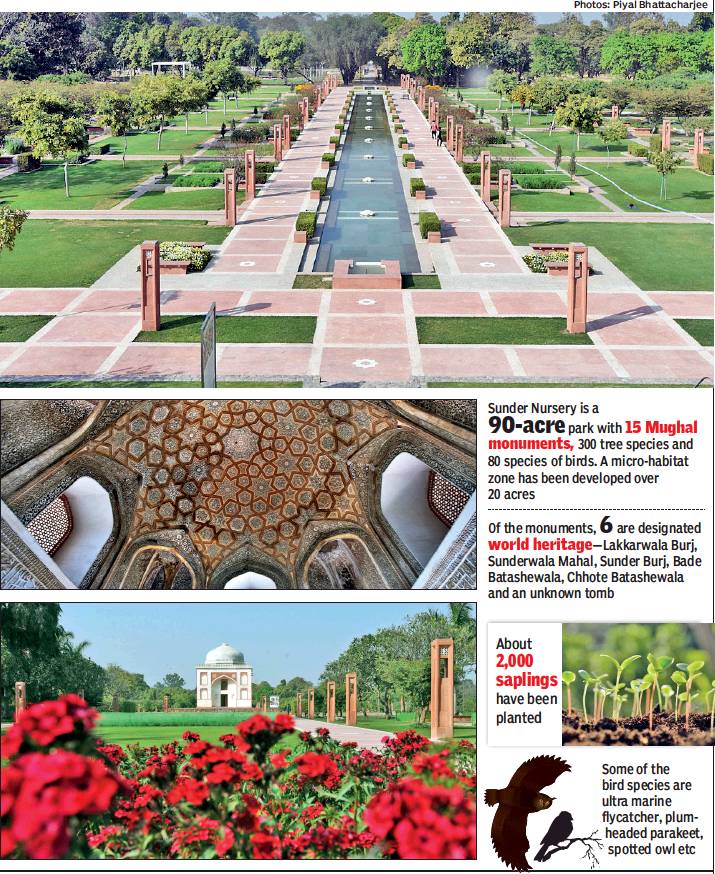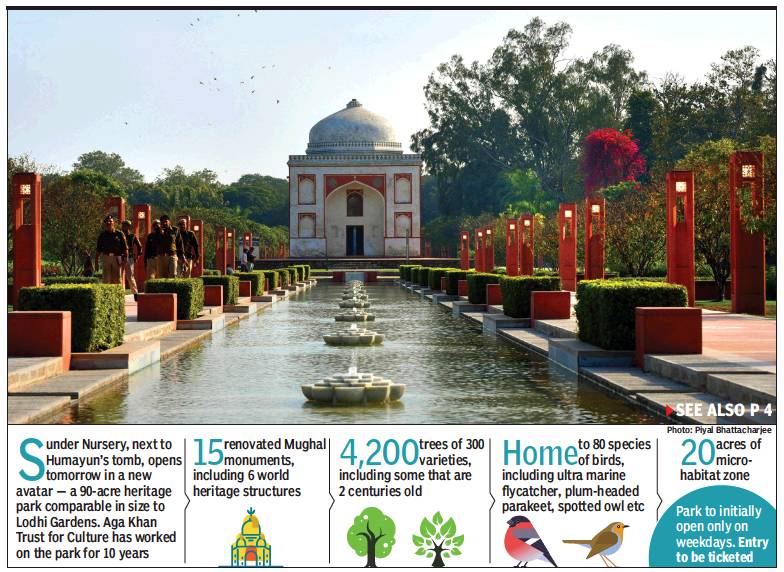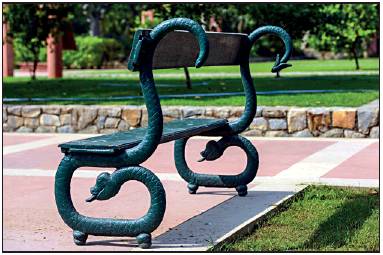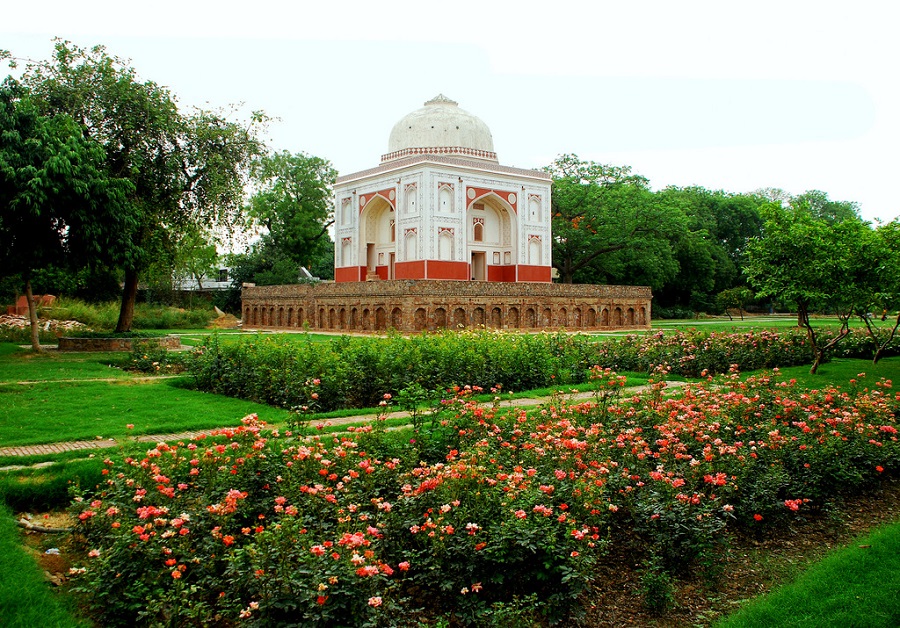Delhi: Sunder Nursery
This is a collection of articles archived for the excellence of their content. |
Contents |
Sunder Nursery
RETURN OF THE MUGHAL
Sunder Nursery was a Mughal garden once, and will be again in
Richi Verma | TNN
The Times of India 2013/08/31
The Sunderwala Burj, sleeps undisturbed behind the tall gates of Sunder Nursery just across the road. Few know the nursery as anything more than a seedbed for the trees and flowers in Lutyens’ Delhi, but that is set to change soon.
Quietly, the sprawling property is being transformed into an authentic Mughal garden laid around a central axis with monuments, fountains, water bodies and a large variety of tree and bird species. The project’s landscape planner, Mohammed Shaheer, says the aim is to conserve the environment and create a “major landscaped space” aligning nature and utility in a garden.
The Aga Khan Trust for Culture (AKTC), is partnering Archaeological Survey of India and the site owner, Central Public Works Department, in the project
The project was conceived while AKTC was restoring the gardens of Humayun’s Tomb during 1997-2003. When they are completed in 2015, the Sunder Nursery gardens will cover 100 acres across the nursery and the adjoining Batashewala complex. Shaheer says the gardens will have a microhabitat zone for plants found on Delhi’s ridge, river banks, plains and other zones.
Edged by nine mounds, the microhabitat zone will replicate Delhi’s original landscape to increase environmental awareness among the 3 lakh schoolchildren who visit Humayun’s Tomb every year. AKTC has recorded 1,800 mature trees of more than 200 species at the nursery on a geographic information system (GIS) and planted another 100-odd species. “Biodiversity studies in 2012 documented 54 species of resident birds and 24 species of butterflies,’’ said an official.
Besides the Sunderwala Burj, the nursery also has eight early-Mughal era monuments that have been restored after years of neglect. Three of them—Sunderwala Burj, Lakkarwala Burj and Sunderwala Mahal—have been declared monuments of national importance by the ASI. However, other structures, including ancient wells, a Mughal pavilion, a mosque and several graveyards are unprotected but equally striking. Two monuments in the adjunct Bateshewala complex are also with ASI.
For the complex as a whole, the changes mark a return to past glory. Before the British turned it into a nursery in 1913, it was called Azim Bagh. “Historically, the entire area from Humayun’s Tomb to Millennium Park (along the Yamuna) was a Mughal garden,” says Ashok Khurana, retired director general of CPWD in whose tenure the project was conceived.
AKTC has offered to manage Sunder Nursery until it becomes financially sustainable. “Discussions for postproject management of the park are now in an advanced state with AKTC underwriting all management and maintenance costs for 10 years,’’ said Ratish Nanda, project director of AKTC. Already, parallels are being drawn between the gardens and New York’s iconic Central Park.
2018
As a heritage park

From: Richi Verma, 10 years on, Sunder Nursery to debut as a heritage park, February 20, 2018: The Times of India

From: February 20, 2018: The Times of India
At 90 acres, Sunder Nursery is comparable in size to the famed Lodhi Garden. But it doesn’t receive many visitors as it’s just a place to buy plants. This is set to change as a renovated Sunder Nursery opens to the public as a heritage park.
For over a century, this place has been a nursery, and 20 acres are still an active nursery maintained by CPWD. The rest of the area would now be a treat for nature lovers and heritage enthusiasts. The nursery was renovated by Aga Khan Trust for Culture (AKTC), and following an agreement signed last December, AKTC would maintain the park for 10 years. For that, requisite infrastructure would be built such as a garden house to showcase flora, a cafe, toilets etc.
So far, the park is open only on weekdays up to 5pm. This would be stretched and even weekends would be open days. Security and other maintenance infrastructure would be put in place by October. Entry would be ticketed.
Sunder Nursery rivals the Rashtrapati Bhavan for the huge variety of flora and fauna. Earlier, the area only housed Mughal garden tombs. At the beginning of the 20th century, the British converted the area into a nursery for the new capital city. In 2007, following an MoU between CPWD, ASI, the municipal corporation and AKTC, conservation and landscaping works started. AKTC has built similar parks in Kabul, Cairo, Chantilly (France) and Edmonton (Canada).
Designed by landscape architect Late M Shaheer, Sunder Nursery has a 550m ornamental central vista that starts from the entrance zone of Humayun’s Tomb. An official said the landscape master plan derived inspiration from the “traditional Indian concept of congruency between nature, garden and utility coupled with environmental conservation”.
The gardens along the central vista, inspired by Mughal traditions, have lotus-shaped marble fountains. Water flows through geometric flowerbeds and raised sandstone pathways. A lake on the northern edge of the central vista will have walkways, seats and pavilions along the edges. An amphitheatre has also been built for cultural events. The lake would collect rainwater and also serve as a reservoir for emergency use.
Officials said the nursery has over 300 tree species, some not found elsewhere in Delhi. Over 80 bird species have also been recorded. As an added attraction for children, an educational resource on Delhi’s ecology has also been set up for the 5,00,000 schoolchildren who visit the adjoining Humayun’s Tomb annually. This 20-acre micro-habitat zone showcases plants of the Ridge, and the riverine, marshy landscapes that were once found in Delhi.
The heritage aspect is striking too. There are 15 Mughal monuments within the nursery, some under ASI and some unprotected. These have been conserved by AKTC over the years. In 2016, Unesco extended the world heritage designation to 12 monuments.
Victorian-era iron benches

From: Richi Verma, At Sunder Nursery, relax on Victorian-era iron benches and admire Mughal heritage, October 28, 2018: The Times of India

From: Richi Verma, At Sunder Nursery, relax on Victorian-era iron benches and admire Mughal heritage, October 28, 2018: The Times of India
Come November and Sunder Nursery will welcome visitors in a new avatar. While the monument will become ticketed, it will also have a large number of antique benches, many of which are over a century old.
These benches are either Victorian originals or inspired by them, prepared in metal workshops in England and Scotland. Nearly a hundred such benches are being placed at the heritage site in at least 20 different patterns. The oldest of the benches are over 100 years old and the newest is about 30-40 years old.
The benches have been repaired and restored by Aga Khan Trust for Culture, which has restored the park and has been maintaining it in agreement with CPWD. At first look, the benches appear ordinary cast iron ones painted British military green. A closer look reveals Victorianera designs seen in England in the 19th and early 20th centuries.
“English blast furnaces from about the late 18th century started making lighter and thinner cast iron—ideal for garden furniture,” said a historian.
Brought from Gujarat through antique dealers, the benches took several months to repair as their original designs and patterns had to be restored. “These benches will supplement the sandstone benches that are to be placed along the pathways and lakes. People can also dedicate these benches to the memory of their loved ones—by paying their price and up to 10 years of maintenance costs—as a practice followed in major public parks worldwide,” said an AKTC official.
Since the renovated park was opened in February, over 2 lakh people have visited it. Entry was free until now, but from November, Indian visitors will have to pay Rs 30 and foreigners Rs 100. Visiting hours will be from sunrise to sunset, like all ASI monuments. It also has basic amenities, toilet blocks and CCTV surveillance.
International acclaim
2018: Among Time’s World’s 100 greatest places
Richi Verma, Sunder Nursery in top 100 places to visit, October 12, 2018: The Times of India
Come November 1, and Delhi’s Sunder Nursery will cost Indian visitors Rs 30 and foreign nationals Rs 100 for admission. But that will be a small price to pay for what Time magazine calls the world’s 100 greatest places to visit, stay in or dine at. Restored in phases since 2007, the Aga Khan Trust for Culture has now completed the infrastructure required to make Sunder Nursery a ticketed site.
The restored Mughal-era complex adjacent to Humayun’s Tomb in south Delhi was opened to the public in February this year and has been visited by over two lakh people since. For over a century, it had been the capital’s most popular plant nursery, and even today 20 of its 60 acres are used as a source for plants by Central Public Works Department.
The heritage complex has 12 monuments designated as World Heritage Sites by Unesco, six of them in Sunder Nursery: Lakkarwala Burj, Sunder Burj, Sunderwala Mahal, Mirza Muzaffar Hussain’s tomb, Chhota Batashewala and the Unknown Mughal’s tomb. The conservation work on Humayun’s Tomb and these monuments had drawn attention to this being a unique ensemble of 16th century garden tombs.
Designed by the late landscape architect M Shaheer, Sunder Nursery has a 550-metre-long ornamental central vista starts from the entrance zone of Humayun’s Tomb. The gardens along the central vista, inspired by Mughal traditions, employ lotus-shaped marble fountains, geometric flower beds and raised sandstone pathways. According to officials, the park has over 300 tree species, some not found anywhere else in Delhi, Sunder Nursery the city’s first arboretum. Over 80 bird species have been recorded here.
In its annual list of the World’s Greatest Places, 2018, Time magazine has named Sunder Nursery as a must-visit place among iconic spots from 48 countries. The magazine described the park as “a horticultural haven with restored Mughal-era monuments and water features”. The three other Indian entries in the list are Indian Accent in New Delhi for dining and Alila Fort Bishangarh in Rajasthan and Oberoi Sukhvilas Resort & Spa in Chandigarh for staying in.
“Following a decade of persistent effort, Sunder Nursery is beginning to now serve as a heritage and ecological hub for Delhi,” beamed Raish Nanda, CEO, AKTC. “Since the February inauguration, critical facilities have been built and several additional attractions are planned, including Delhi’s first ever specialist structure to display tropical flora.” Under an agreement signed in December 2017, AKTC will maintain the park for 10 years.



